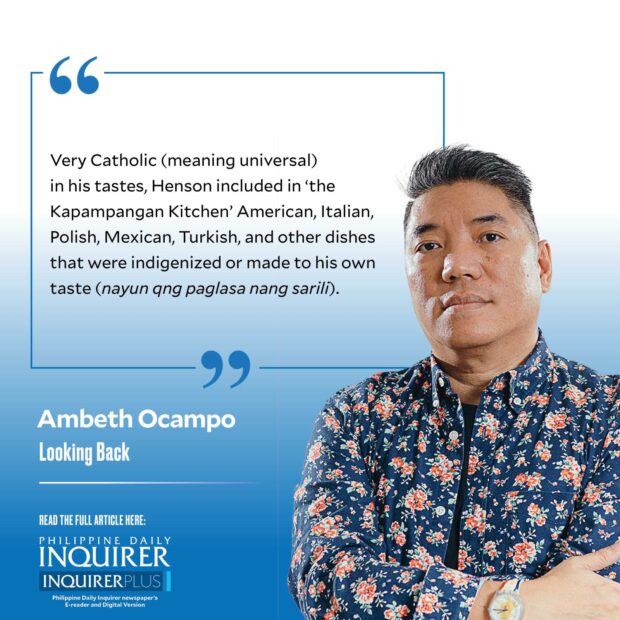Identity in recipe books

Concluding at Holy Angel University today is the first international conference on Kapampangan Cuisine and Food Tourism. I had planned to present a paper on cookbooks after digging into my files for all Manila envelopes marked “Food.” First item that emerged was Mariano Henson’s mimeographed “Cusinang Capampangan” (1968) whose table of contents alone is worth a lecture. This is not a mere listing of recipes and corresponding page numbers. Serving size, in “bandejados,” is indicated as well as ingredients at 1936 market prices!
Henson planned to present 150 recipes but only came up with 133. In the list, we recognize Kapampangan dishes like: pancit luglug, sigang, kilawin, adobong manuc at babi, lagat repollo, suam maiz caraniwan, asado Pampango, bulanglang bangus, begucan, etc. Henson was obviously cosmopolitan so the recipes included “lutung intsik” or Chinese dishes like: quim-chi-je, cuy-wan, how yau gai kow, and pansit miki bijon. Four centuries of Spanish cuisine in the Philippines are represented in: cocido a la Española, pescado en blanco, lengua a la marinera, morisqueta tostada (fried rice), asado de cerdo, bacalao a la vizcaina, etc. Some items had Spanish names with Kapampangan thrown in because of local ingredients: croquetas balatung-maiz [mongo-corn coquettes), albondigas babi at paro salsang camatis (pork and shrimp meatballs in tomato sauce), chuletas balasenas (eggplant chops), etc. French dishes are also found in his cookbook: fish filet with Béarnaise sauce. Paro a la creole (shrimp creole), crème de la crème, salmon au gratin, bouillabaisse de marsella, oysters a la D’Uxelles, mechadong solomillo a la Francesca, etc.
Very Catholic (meaning universal) in his tastes, Henson included in “the Kapampangan Kitchen” American, Italian, Polish, Mexican, Turkish, and other dishes that were indigenized or made to his own taste (nayun qng paglasa nang sarili). Henson’s 1968 mimeograph “Cusinang Capampangan” was translated into English as “Finger Lickin’ Pampanga Delicacies” (1974) with an additional 30 recipes. Unfortunately, the 1936 prices that I found quaint were deleted from the 1974 version. Comparing the two, the changes are not just linguistic but technological. For example, the “icebox” or “nevera” of 1936 became a refrigerator in 1974. Macaroni soup garnish of asparagus and artichoke in 1936 was omitted in 1974. If I had the time, I would compare and contrast these two texts, extracting from them not just culinary history, but more importantly the social history that both informs and contextualizes the food. In the 1936 edition, recipe 22 is for “Commonwealth Gulay.” What is that? And recipe 141 “Famous Bola-bolas of Ateneo de Manila” is intriguing as Henson said it was “how we eat them in the Spanish Ateneo de Manila since Dr. Jose Rizal’s time.”
Another cookbook from the pile was “Pamagconserva at Pamaglutung Filipino” (1934) that was a Kapampangan translation of “Mga paglulutong Filipino at pagcoconserva” by Pura Villanueva Kalaw and, not indicated on the cover and title page, Maria Orosa. Earlier cookbooks on file are: “La Cocina Filipina” (1913), “Condimentos indigenas” (1918) by Pura Villanueva Kalaw, and “Aklat ng pagluluto hinango sa lalong bantog at dakilang aklat ng pagluluto sa gawing Europa at sa Filipinas, na kapwa nasusulat sa wikang Kastila, at isinatagalog ng boong katiyagaan” (1919) by Rosendo Ignacio. Not all materials are in book form, some are unpublished manuscripts like the notebooks and loose papers of the ill-fated Juliana Gorricho, mother-in-law of Juan Luna, who replicated the tastes of home, of the Philippines in the 1880s Paris.
On Jan. 1, 1886, Doña Juliana cooked a New Year dinner for 10 people that included the painters Rafael Enriquez, Gaston O’Farrell, Juan Luna, and Felix Resurrección Hidalgo. On Oct. 11, 1891, she made meatballs or albondigas for 10 people that included: Jose Rizal, Fernando Canon, a certain Vergel, and the Kapampangan Valentin Ventura. From some of Juliana’s recipes, we can taste what our heroes ate.
In 1991, when I went abroad for postgraduate studies, my mother provided a survival cookbook. As a mother, she knew that these would remind me of home. Unlike today, Asian stores then did not carry Filipino staples like Chippy, patis, adobo mix, Magic Sarap, or sinigang bouillon, so I was forced to cook from scratch using available ingredients.
My mother’s paksiw, sinigang, and daing na bangus were substituted with trout. With no tamarind for sinigang, souring was replicated with tomato and lemon. Abroad I learned that mashed blood sausages in vinegar could approximate dinuguan, smoked herring tasted like tinapa. Beef tapa was just sirloin kneaded in a salt/sugar mixture, but on my last trip, I skipped the process and used teriyaki flavor beef jerky!
The most intriguing item in my food file is a manuscript of an 18th-century friar cookbook: “Tratado de Varios Guisados y conservas” that has a recipe for tinola and longganisa, references to local ingredients like camias and balimbing, recipes for jaleang sampaloc and jaleang santol. Recipe books can be read as expressions of who we are.
—————-
Comments are welcome at aocampo@ateneo.edu




















